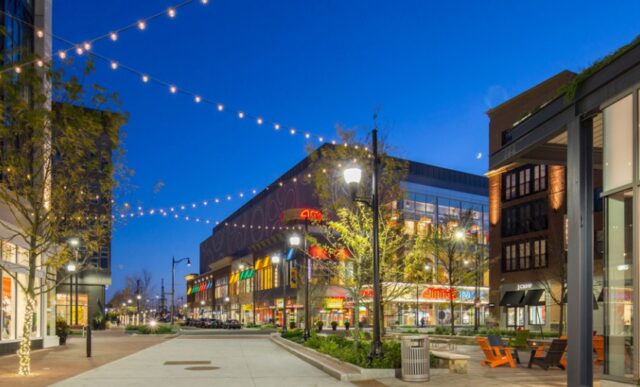
Redevelopment in Alewife’s Quad district off Concord Avenue is accelerating to accommodate life science industry expansion. Cabot, Cabot & Forbes is proposing a 1 million-square-foot life science and multifamily project on Mooney Street including a pedestrian bridge improving access to the MBTA’s Alewife station. Image courtesy of Cabot, Cabot & Forbes and Sasaki
With its suburban-style strip malls and industrial parcels tucked away near the Belmont line, Alewife was late to cash in on Cambridge’s commercial real estate boom.
Now that Wall Street investors have discovered the neighborhood and its fast-growing life science cluster, change seems inevitable and Cambridge officials have completed a playbook designed to shape future development.
They envision an Assembly Row-style development replacing the aging Fresh Pond Shopping Mall. A green light for multifamily housing, with potential for another 4,000 residences. And a mix of commercial and residential buildings in the Quadrangle district off Concord Avenue, including space reserved for the one of the city’s last industrial remnants. The recommendations are part of the Alewife District Plan, which divides the neighborhood into six potential zoning districts and lays out a vision for mixed-use developments with density bonuses for new roads, public infrastructure and open space.
“This is Cambridge’s last real shot to add commercial space on a large scale to maintain its preeminence in life science,” said Aaron Jodka, managing director of client services at Colliers International in Boston.
Even before the plan is adopted, developers are moving ahead with transformative projects. Boston-based Cabot, Cabot & Forbes is proposing a 1 million-square-foot residential and life science development on the former Mabardy Sand & Gravel property on Mooney Street.
A Beacon for Transit-Oriented Development
Things started to change dramatically in West Cambridge in 2013, when the MBTA Red Line station acted as a homing beacon in an era of transit-oriented development. Multifamily developers came first, building 1,382 housing units, most on Cambridgepark Drive, between 2013 and 2016.

Cambridge officials have inked a plan that opens up the possibility that the aging Fresh Pond Mall property could be redeveloped into an Assembly Row-like project, but longtime owners seem happy to stay put. Image courtesy of the city of Cambridge
Then the life science crowd arrived at the party, as developers kicked off speculative lab projects and lured biotech companies unable to find space in Kendall Square. The Davis Cos.’ 225,000-square-foot Alewife Research Center on Cambridgepark Drive was fully leased in June, less than a year after completion, while Bulfinch Cos. already has preleased all but 30,000 square feet at its 270,000-square-foot spec building in Cambridge Discovery Park.
As the life science cluster has grown, triple-net rents for lab space have increased from mid- $40s per square foot in 2014 to the mid-$70s, said Eric Smith, an executive vice president at CBRE in Boston.
With Cambridgepark Drive largely built out, commercial developers have turned their attention to the Quadrangle district off Concord Avenue, despite its significantly longer walking distance from the T station.
The Davis Cos. and its partner Invesco Real Estate planted a flag in 2018, buying four parcels spanning 9 acres with a strategy of converting commercial buildings into life science space over time. Invaio Sciences leased the 37,500-square-foot building at 75 Moulton St. and an undisclosed biotech firm recently leased 30,000 square feet at 10 Wilson Road following building and site upgrades.
“It’s a more polished environment that resonates with the life science companies who are trying to attract some of the best and brightest talent in Greater Boston,” CBRE’s Smith said.
As the life science cluster has grown, triple-net rents for lab space have increased from mid- $40s per square foot in 2014 to the mid-$70s, said Eric Smith, an executive vice president at CBRE in Boston.
The Mooney street parcels are part of a proposed subdistrict that requires industrial space on ground floors in the Quad despite the lower rents that such tenants typically pay. There’s little precedent in Greater Boston for that strategy supporting new construction, said Tony Hayes, a first vice president for CBRE capital markets.
CC&F’s Doherty agreed that the industrial requirement makes the Mooney Street project hard to build without zoning relief. The company is seeking building heights up to 85 feet as it seeks to retain the Central Rock Gym rock-climbing club as a tenant and amenity in the new development.
Fresh Pond Mall Ripe for Redevelopment
Anchored by Whole Foods Market, the 17-acre Fresh Pond Mall property has ample room for an Assembly Row-type redevelopment.

Steve Adams
Local real estate brokers say the property is a can’t-miss opportunity, but the longtime owners haven’t shown any interest in selling or a redevelopment. The property has been owned for decades by Vast Capital Management, a Concord Avenue real estate company that also has holdings in Arlington and Watertown. Company executives did not return messages seeking comment.
Under the city’s Alewife District Plan, both the Fresh Pond Mall and the Trader Joe’s-anchored shopping center on the other side of Alewife Brook Parkway would be part of a shopping center zoning district. Uses would include housing, office space and retail, with maximum building heights of 85 feet.
Colliers’ Jodka said the addition of more housing in the Quad will solidify its position as an economic hub.
“We see this as a prime growth corridor for Cambridge where new zoning and aggregation of properties will result in substantial new development over time,” he said. “The pedestrian bridge will be very important, because one of the current challenges is getting in and out of there efficiently.”




 |
| 

